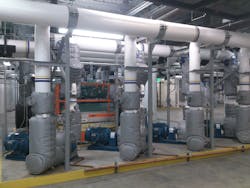Seize Significant Savings
As airports are rapidly growing and using more natural resources, aviation leaders are aggressively seeking opportunities to increase efficiency and cut costs. The ongoing search for Airlines to save operating cost include saving fuel while parked at the gate. Taking a critical look at the airport’s internal systems and the relationship between the building, the aircraft, and the external support infrastructure can reveal opportunities to save energy and, therefore, cut costs in the day-to-day operation of the facility.
Aviation fuel represents 40% of an airline’s costs, transitioning away from using auxiliary power units for heating/cooling at the gate. Preconditioned air systems (PCA)—either point-of-use or central systems—are the preferred solution and a strategy to improve an airline’s bottom line. First costs differ between the two, but central systems often offer a three to five year payback and then 25 additional years of financial benefits.
Benefits abound with centralized systems. A water-cooled central system consumes 60% less energy than point-of-use, reduces lifecycle costs, and keeps valuable components indoors, extending equipment life. A PCA system improves air quality and reduces noise around the airport and increases ground service equipment energy efficiency, resulting in jet fuel savings and reductions in carbon dioxide and other gas emissions – not to mention comfort continuity for passengers when preconditioned air is extended to the boarding bridge. While the benefits are numerous, implementing such a systemic change requires thoughtful consideration and savvy planning.
Weighing Options: Centralized vs. Point of Use
Data-driven, performance-based decisions. Airports, rather than airlines, are increasingly funding terminal construction. Airports are discovering central systems are beneficial for lowering energy costs over the life of a terminal. This is especially true if the airport doesn’t already have a central system. Composing a clear picture of the life cycle cost—shared by the airlines and the airport—helps foster the buy-in required to navigate a new, better path. To do this accurately, project teams use flight schedules for the specific airport to “right size” equipment, minimizing first cost. Careful, data driven analysis then quantifies the increased efficiency resulting from central systems.
Many decision makers reach out to project teams because they have some familiarity with the benefits of centralized systems and are asking for more specific, technical information. They may have visited or previously worked in a facility that had a centralized system or have simply done research. Regardless of their current knowledge level, the key is for decision makers to see performance-based data demonstrating how a centralized system can improve performance of their facility. Reviewing lifecycle cost analysis specific to the project often demonstrates the potential savings to decision makers.
Infrastructure savings + ROI: putting first costs in context. With the guidance of an aviation savvy expert, decision makers can see the benefits of such an installation, understanding first costs in context. Once project stakeholders see the full range of performance-based ROI data, they realize the long-term benefit of a higher initial investment. When airports go to central systems, they also have the opportunity to create diversity by combining systems. This diversity aids in future expansion and long term planning.
For instance, not every plane is at the gate at the same time, so if a group of aircraft are cooled and heated by a central system, it isn’t running at full load all the time, allowing for smaller—and less expensive—equipment and mechanical piping. Alternately, point-of-use configuration requires full-sized equipment, and, per the national electrical code (NEC), all the wire and distribution must be sized for a 100% full, connected load. Therefore, the savings on electrical infrastructure offsets the higher initial cost of the central system chillers or heating equipment.
Central systems are inherently more efficient, while holistic assessment verifies site specific details on lifecycle advantages. A central system is inherently more efficient than a point-of-use system, but facility and site-specific details are helpful, with special focus on lifecycle cost analysis and return on investment (ROI) data. The location and physical configuration of the airport and the ambient conditions of the region impact system design. (Part of the reason is to conserve central system costs as airport layout at Sea-Tac keeps all terminals and gates close, minimizing infrastructure costs.) Beyond climate factors, differing rate structures for utilities in that area affect the design as well.
Project teams must take a holistic approach, assessing how building systems, coupled with the PCA system, can benefit the project as a whole. Team leaders discuss their findings and a series of options – the result of a multi-disciplined project team synthesizing system design and flight operations. This holistic, solution-focused process empowers Owners to understand the true energy, emissions and maintenance savings that these systems provide: the “holy grail” for an owner – the ultimate GREEN (comfort, emissions, and money).
Quantifying Data Underneath Energy Savings
Comparing energy consumption: point of use vs. centralized. From an energy savings perspective, centralized systems provide a significant advantage. The kW per ton difference between an Auxiliary Power Unit (APU), Point-of-Use, and Centralized systems is reduced from approximately 5.5 to 2.3, down to 1.1 kW/Ton. Project team leaders are encouraged to consider implementation in the context of evolving LEED criteria for energy consumption.
The United States Green Building Council (USGBC) is considering including ground service equipment energy for aircraft as part of the building’s total energy consumption. In the past, aircraft energy was considered a process load that was not reviewed or considered in building energy consumption from a heating and cooling standpoint. Using building utilities to feed the aircraft has a tremendous impact on total energy consumption. Considering this energy conservation measure of using the central system, can potentially provide up to a 28% energy savings on average over point of use.
Although this utility is for the aircraft, and is considered ground service equipment, and therefore not part of building energy consumption, it is recommended that the project team explore considering this system as an innovation credit.
LEED Energy and Atmosphere Credit. Digging deeper into how this opportunity developed, it was driven by engineers who were looking for a way to realize the energy savings gained by using Central Systems towards the project overall benefit. To raise awareness of this issue and to drive industry-wide change by promoting the credit, project team experts in conjunction with USGBC leaders objectively define this credit for airports.
To accomplish this, the project team worked with manufacturers to create a list of 100 airports and categorized them by number passengers per year and whether they used a centralized or point-of-use system. The team factored the 10 most similar in size to the example project and compared the numbers for centralized systems against the point-of-use examples. These figures provided quantitative data to the USBGC about energy usage by size of facility for the Energy and Atmosphere (EA) credit, which informs project planning and decision making.
The purpose of the exercise was to validate that since point of use systems are more common. When the airport invests in a central system, it should be considered as an additional energy conservation measure, and not industry standard.
Study findings validate unique standards for airports. Because LEED criteria apply to many building types, part of the underlying intent of this logistical analysis for the innovation credit is to show how airports have different energy needs, distinct from other buildings. After the analysis, the team found that airports have a substantial process load compared to other buildings and should have different performance standards, similar to data centers and other facilities with a higher than average load.
It is inevitable that airports will use more energy, but they should get credit for finding innovative ways to reduce consumption, even if they still use more energy than a school or office building.
The idea is that, although energy consumption is relatively higher and fluctuates more as planes come and go, airports will continue to make progress and set the energy savings bar higher as time goes on and technology improves. Recent LEED certified projects that have taken advantage of central preconditioned air are receiving EA credits for optimized energy performance, saving 30% of the overall cooling load due to the installation of centralized systems.
Seizing Additional Efficiencies
Consolidation. In addition to inherent efficiencies, consolidation is an optimal way to get diversity from a system, so leaders thinking of implementing a central system can further reduce costs by finding ways to link systems. The best approach is to start by examining existing systems to see where they can be expanded and joined with other systems. For example, two buildings of a similar size could potentially be tied together, resulting in both operating at a lower net capacity. The sharing of cooling and heating systems from a central plant across multiple buildings is another way to consolidate operations to increase efficiency.
Sharing resources. Any opportunity to share resources – including space, chilled, condenser, and hot water infrastructure, etc. – from one terminal or area to another is an opportunity to increase efficiency and reduce energy consumption while lowering costs. Industry leaders are increasingly creative about how they can achieve success in an airport application as the market demands it, while still providing the same level of comfort to airline passengers and others who use the airport. Once they have all the information, owners understand how much more efficient a centralized system is and why it is a worthwhile investment to improve efficiency of operations for decades to come.
Finding Space Solutions
Locating space for the centralized equipment can be a challenge. Space at the ramp level is at a premium and the equipment itself is large. Stakeholders compete for the space at the ramp level: General storage and airline operations spaces with parts storage and workshops for the people who service the planes between flights. Electrical rooms, baggage belts, technology equipment, and mechanical rooms that serve the terminal also compete for this space.
At the same time, the height of the ramp level must be high enough to accommodate centralized infrastructure equipment, and the overall area is generally crowded, often understandably resulting in resistance when additional infrastructure space is proposed. Some of this space would have been consumed by electrical gear regardless, because every system needs power, whether central or point-of-use. Point-of-use systems would have larger electrical distribution gear that has to go somewhere. Many are often surprised to find that the net area added is only about 30% more. Coupling the Central PCA heat rejection to the Building Chilled Water system can offset space by eliminating the need for cooling towers at the Airside.
All of the stakeholders in the ramp-level space have to make a case to defend their need for space on this level, and the case is strong for a centralized system.
Seizing Savings
Airports inevitably consume significant quantities of energy, which comes at a high cost. As energy prices rise and the emphasis on sustainability and reduced consumption continue to strengthen as market trends, industry leaders are looking to invest in solutions that will reduce energy and costs for the long term, especially as airport funding models shift. Installing a central system in an airport requires data collection, quantifiable investment analysis and concise planning due to the complex nature of the system. However, the proven benefits of energy and emissions reductions, coupled with excellent return on investment, show that centralized PCA is a system that should be seriously considered at all airport terminals.
Dominic J. Cacolici, PE, is Principal with TLC Engineering Solutions and can be reached at [email protected].
Kevin D. Keiter, PE, Principal is Principal with TLC Engineering Solutions and can be reached at [email protected].
About the Author

Dominic Cacolici
Principal

